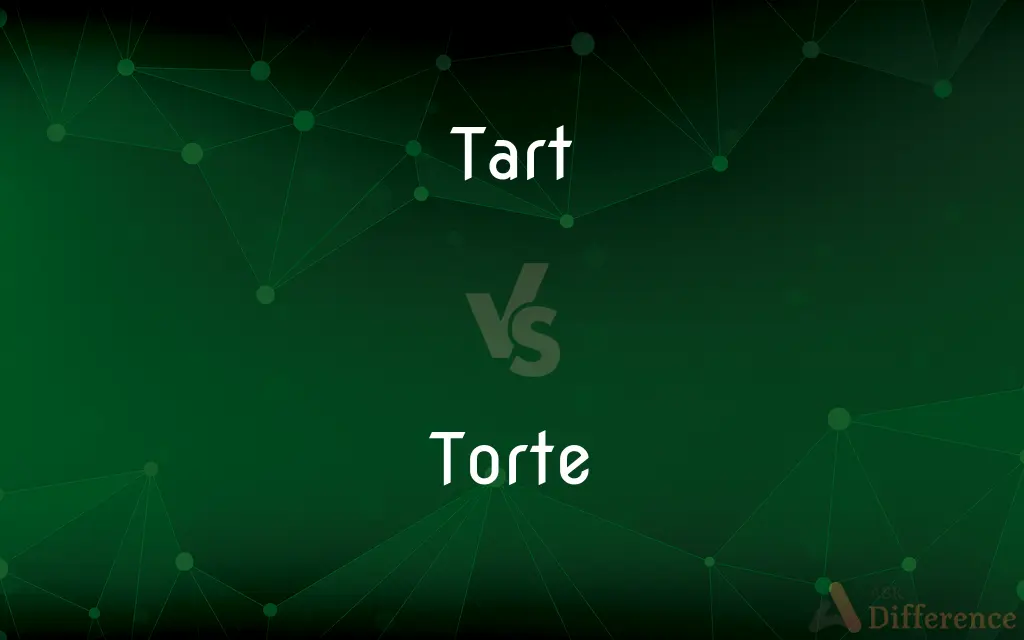Tart vs. Torte — What's the Difference?
By Maham Liaqat & Fiza Rafique — Updated on February 22, 2024
A tart is an open pastry case containing a filling, often fruity or custardy, while a torte is a rich, dense cake made with many eggs and little to no flour, often layered with fruit or cream.

Difference Between Tart and Torte
Table of Contents
ADVERTISEMENT
Key Differences
Tarts are characterized by their shallow pastry shells and lack of a top crust, showcasing their fillings, which range from fruits to custards and more. The crust is typically made from pastry dough, offering a crisp texture. Tortes, on the other hand, are European in origin and are known for their richness and moistness, achieved through a high content of eggs and minimal flour. This results in a cake that is denser than traditional cakes and often includes nuts, breadcrumbs, or ground almonds as a flour substitute.
The distinction between tarts and tortes extends beyond ingredients to their presentation and occasion. Tarts are often served as a dessert or a sweet treat, with their open tops beautifully displaying the filling, making them as visually appealing as they are delicious. Tortes, with their dense texture and rich flavor, are typically reserved for special occasions and can be elaborately decorated with layers of cream, fruit, or glazes.
Tarts can be sweet or savory, offering versatility in their preparation. Savory versions might include fillings like cheese, eggs, and vegetables, making them suitable for a broader range of dining occasions, from appetizers to main courses. Tortes, due to their richness and sweetness, are almost exclusively served as desserts, often accompanied by a dusting of powdered sugar, cocoa, or a glaze to enhance their flavor.
Both tarts and tortes hold significant places in culinary traditions, with tarts being a staple in French cuisine and tortes in Central and Eastern European countries. Despite their differences, both are celebrated for their delightful flavors and textures, showcasing the variety and creativity in dessert making.
Comparison Chart
Base
Pastry dough, typically crisp and buttery.
Dense, often made with eggs and minimal to no flour, sometimes replaced by ground nuts or breadcrumbs.
ADVERTISEMENT
Presentation
Open-faced with visible filling.
Layered cake, often coated with cream, fruit, or glazes.
Texture
Crisp and firm shell with a soft filling.
Moist and dense, richer than typical cakes.
Occasion
Versatile, served as dessert or savory dish.
Usually reserved for special occasions, primarily as a dessert.
Varieties
Sweet (fruits, custards) and savory (cheese, vegetables).
Mostly sweet, with variations in nuts, chocolate, and fruit layers.
Compare with Definitions
Tart
An open pastry case with a filling.
She made a lemon tart for dessert.
Torte
A dense, moist cake made with eggs.
For his birthday, they ordered a chocolate torte.
Tart
Can be sweet or savory.
For the picnic, they packed a spinach and feta tart.
Torte
Rich and flavorful, a decadent dessert.
The coffee torte was a hit at the dinner party.
Tart
Features a crisp, buttery crust.
The apple tart had a perfectly golden crust.
Torte
Minimal to no flour, sometimes nuts are used.
The almond torte was gluten-free.
Tart
Served as a dessert or part of a meal.
The tomato tart was a delicious appetizer.
Torte
Served on special occasions.
Their wedding featured an exquisite three-layer torte.
Tart
Filling is visible and often decorative.
The berry tart was decorated with an array of colorful fruit.
Torte
Often layered with cream or fruit.
The raspberry torte was filled with fresh cream.
Tart
A tart is a baked dish consisting of a filling over a pastry base with an open top not covered with pastry. The pastry is usually shortcrust pastry; the filling may be sweet or savoury, though modern tarts are usually fruit-based, sometimes with custard.
Torte
A rich, dense cake, typically made with many eggs and relatively little flour (as opposed to a sponge cake or gâteau).
Tart
Pastry cup with a filling of fruit or custard and no top crust.
Torte
A rich cake made with many eggs and little flour and usually containing chopped nuts.
Common Curiosities
Can tortes be made without nuts?
Yes, though nuts are common for adding texture and flavor, tortes can also be made with alternative ingredients like breadcrumbs or dense fruit purées.
Is a torte considered a cake?
Yes, a torte is a type of cake, known for its dense texture and rich flavor, differing from traditional cakes by using minimal to no flour.
What makes a tart different from a pie?
A tart has a shallow pastry base and often no top crust, whereas a pie typically has a deeper dish and may have a top crust.
Are tarts always sweet?
No, tarts can be both sweet and savory, with fillings ranging from fruit and custard to cheese and vegetables.
Can a tart be considered a dessert only?
While often served as a dessert, tarts' versatility also makes them suitable for appetizers or main courses when prepared with savory fillings.
How do you serve a torte?
Tortes can be served as is or enhanced with powdered sugar, cocoa, glazes, or accompanied by whipped cream or fruit.
What's the origin of tarts?
Tarts have roots in European cuisine, particularly French, known for their patisserie skills in making exquisite tarts.
Is special equipment needed to make tarts or tortes?
For tarts, a tart pan with a removable bottom is helpful for creating a beautifully presented dessert. Tortes may require springform pans to accommodate their dense, moist texture.
How do the flavors of tarts and tortes compare?
Tarts can range widely in flavor depending on the filling, from tangy citrus to savory cheese. Tortes are typically rich and decadent, often featuring chocolate, nuts, or fruit.
What's the best way to store a tart?
Most tarts are best stored in the refrigerator, especially those with custard or cream fillings, and consumed within a few days.
Can you freeze a torte?
Yes, most tortes freeze well. Wrap them tightly to prevent freezer burn and thaw in the refrigerator before serving.
How long does a torte last?
Stored properly in the refrigerator, a torte can last several days. However, its optimal flavor and texture are best enjoyed within the first few days after baking.
Where do tortes originate from?
Tortes are believed to originate from Central and Eastern Europe, with each country having its own traditional variations.
Can dietary restrictions be accommodated with tarts and tortes?
Yes, both can be adapted for dietary needs, such as using gluten-free flour substitutes or vegan ingredients.
Are tarts or tortes more difficult to make?
Difficulty can vary based on the recipe. Tarts may require skill in pastry making, while tortes may require more intricate steps for layering and decoration.
Share Your Discovery

Previous Comparison
Cheek vs. Chin
Next Comparison
Embedded vs. ImbeddedAuthor Spotlight
Written by
Maham LiaqatCo-written by
Fiza RafiqueFiza Rafique is a skilled content writer at AskDifference.com, where she meticulously refines and enhances written pieces. Drawing from her vast editorial expertise, Fiza ensures clarity, accuracy, and precision in every article. Passionate about language, she continually seeks to elevate the quality of content for readers worldwide.















































